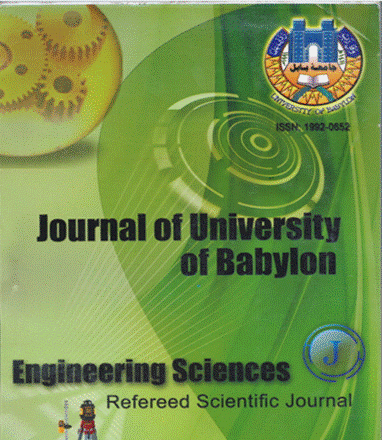Abstract
The research deals with the effect internal sulfates (as gypsum) present in fine aggregate (sand) on the mechanical properties of self-compacting concrete made using a local filler. A mix of self-compacting concrete was designed according special specifications and trials. This mix was tested by various fresh concrete workability tests as Slump-flow, T50cm, L-box, U-box, and V-funnel tests to evaluate the passing ability, filling ability, stability and segregation resistance of the fresh mix.
The gypsum content (as SO3) was varied in sand as (0.4%, 1.0%, 1.5%, 2.5%, and 3.5%) by wt. of sand which yield a total SO3 content in concrete as (3.77%, 4.74%, 5.55%, 7.15%, and 8.77%) by wt. of cement respectively.
The experimental results show that there is an Optimum Gypsum Content in fine aggregate (SO3=1.0%) by wt. of fine aggregate which gives the highest results in compressive strength, splitting tensile strength, flexural strength and Young\'s modulus of elasticity of SCC. As gypsum content increases beyond this limit the above mechanical properties will be decreased remarkably and also SCC reveals softer stiffness mechanical behavior.
The gypsum content (as SO3) was varied in sand as (0.4%, 1.0%, 1.5%, 2.5%, and 3.5%) by wt. of sand which yield a total SO3 content in concrete as (3.77%, 4.74%, 5.55%, 7.15%, and 8.77%) by wt. of cement respectively.
The experimental results show that there is an Optimum Gypsum Content in fine aggregate (SO3=1.0%) by wt. of fine aggregate which gives the highest results in compressive strength, splitting tensile strength, flexural strength and Young\'s modulus of elasticity of SCC. As gypsum content increases beyond this limit the above mechanical properties will be decreased remarkably and also SCC reveals softer stiffness mechanical behavior.
Abstract
يتناول هذا البحث دراسة تأثير محتوى أملاح الكبريتات الداخلية (الجبس) الموجودة في الركام الناعم (الرمل) على الخواص الميكانيكية للخرسانة ذاتية الرص الحاوية على مادة مالئة متوفرة محليا. تم تصميم خلطة خرسانة ذاتية الرص استنادا لمواصفات خاصة مع التجريب. هذه الخلطة الخرسانية الطرية جرى فحصها بفحوص متعددة لقابلية التشغيل مثل: انسياب المخروط وزمن الانسياب والصندوق على شكل L والصندوق على شكل U والقمع على شكل V وذلك لتقييم هذه الخلطة من ناحية قابليتها للمرور وقابليتها للإملاء ومقاومتها للانعزال.
محتوى الجبس (على شكل نسبة SO3) جرى تغيره في الرمل كالأتي: (0.4%,1.0%,1.5%,2.5%, 3.5% ) من وزن الرمل والتي تقابل محتوى SO3 كلي في الخرسانة مقداره )3.77%, 4.74%, 5.55%, 7.16%, 8.77%) من وزن السمنت بالتتابع.
أظهرت النتائج انه توجد نسبة مثلى لمحتوى الجبس في الركام الناعم للخرسانة ذاتية الرص مقدارها (1.0%) من وزن الركام الناعم والتي تعطي أعلى النتائج لمقاومة الانضغاط ومقاومة شد الانشطار ومقاومة الانثناء ومعمل مرونة يونك. وإذا تعدت نسبة الجبس في الركام الناعم عن هذه النسبة فان النتائج أظهرت انخفاضا في الخصائص الميكانيكية أعلاه وكذلك أظهرت سلوكا ميكانيكيا اقل جساءة.
محتوى الجبس (على شكل نسبة SO3) جرى تغيره في الرمل كالأتي: (0.4%,1.0%,1.5%,2.5%, 3.5% ) من وزن الرمل والتي تقابل محتوى SO3 كلي في الخرسانة مقداره )3.77%, 4.74%, 5.55%, 7.16%, 8.77%) من وزن السمنت بالتتابع.
أظهرت النتائج انه توجد نسبة مثلى لمحتوى الجبس في الركام الناعم للخرسانة ذاتية الرص مقدارها (1.0%) من وزن الركام الناعم والتي تعطي أعلى النتائج لمقاومة الانضغاط ومقاومة شد الانشطار ومقاومة الانثناء ومعمل مرونة يونك. وإذا تعدت نسبة الجبس في الركام الناعم عن هذه النسبة فان النتائج أظهرت انخفاضا في الخصائص الميكانيكية أعلاه وكذلك أظهرت سلوكا ميكانيكيا اقل جساءة.
